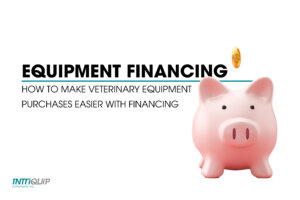Hands-Free X-Ray
Radiography plays an important role in veterinary medicine and can provide essential information about patient health. However, the use of x-rays in veterinary practice can also put staff at increased risk of radiation exposure. Improving radiation safety has long been a top priority, and new techniques are emerging to address exposure concerns. Hands-free x-ray techniques are designed to eliminate the need for manual restraint and allow veterinary staff to obtain images from a safe distance.
In this article, we’ll discuss what you need to know about hands-free x-ray and what tools can help you improve radiation safety in your clinic.
Radiation Safety
Ionizing radiation produced by x-rays can have a significant impact on your long-term health. Repeated radiation exposure increases the risk of cancer and can cause damage to reproductive cells. Dosimeters are often used to monitor radiation exposure. However, even small doses of radiation can have consequences over time.
Unfortunately, veterinary staff often have an increased risk of radiation exposure due to the need to restrain patients. Because of this, safety guidelines have been established to reduce exposure and keep veterinary professionals safe.
One of the leading principles of radiation safety is known as ALARA and is the idea that radiation exposure should be kept “as low as reasonably achievable.” ALARA focuses on three basic protective measures to accomplish this goal and includes:
- Minimizing the time of exposure
- Increasing the distance between staff and radiation source
- Using shielding to protect against various forms of radiation
While these safety principles are relatively broad, they aim to provide a foundation for continued improvements in radiation safety. Regulations set by Health Canada have used these principles to establish specific guidelines for using radiology equipment in veterinary hospitals. Additionally, new efforts are being made to further reduce radiation exposure of veterinary staff.
Hands-Free X-Ray
Manual restraint of patients has long been common practice in veterinary imaging. However, the safety concerns regarding this technique have sparked a conversation about new ways to reduce staff exposure. In 2016, a survey of registered veterinary technicians found that 90% of participants were looking for alternatives to manual restraint while obtaining x-rays. This led to growing interest in a technique referred to as hands-free x-ray.
Hands-free x-ray relies on positioning aids to keep patients in place and obtain quality diagnostic images without the need for manual restraint. Devices such as sandbags and troughs are often used to ensure proper patient alignment and keep patients still. This allows veterinary staff to obtain images from a safe distance and reduce occupational exposure.
The Tools You’ll Need
Since hands-free x-ray relies on alternative means of restraint, there are a few tools that you will need to get started. These tools are designed to keep your patients safe and help you obtain proper alignment for your imaging needs. Here are a few tools you should consider when transitioning to the hands-free technique.
- Sandbags
Sandbags are an excellent alternative to manual restraint and can help you achieve the necessary positioning for quality diagnostic images. The gentle pressure they provide is excellent for keeping limbs in place and reducing movement when staff steps away from the patient.
Sandbags are also incredibly versatile and can adjust to a variety of needs. Intriquip offers sandbag bundles as well as individual bags for purchase. Our sandbags are lightweight and easily conform to your patient’s anatomy. The vinyl covers and double seams provide extended durability and help the product hold up to frequent use.
- Sponges
When it comes to patient positioning, multiple tools may be necessary to achieve the perfect alignment. Sponges are excellent positioning aids that come in various shapes and sizes. Also referred to as wedges or blocks, positioning sponges are usually made of foam and are available with different coating options.
Intriquip offers a variety of Techno-Aide sponges designed to meet your unique positioning needs. Our closed-cell sponges are liquid resistant and composed of artifact-free material to improve image quality. We also offer coated and vinyl-covered sponges. Coated sponges offer a nonporous surface to make cleaning up a breeze. The vinyl-covered sponges also offer sealed seams to improve sanitation.
- Troughs
Troughs are commonly used to reduce motion and keep patients secure on the imaging table. Their V-shape design allows patients to rest comfortably while helping staff achieve proper alignment. The troughs come in multiple sizes and typically include hook and loop straps to provide additional restraint.
The Vinyl Immobilizer Troughs from Intriquip are made of Techno-Tuff vinyl. This material is liquid and stain resistant. Additionally, the Techno-Tuff vinyl is antimicrobial to improve sanitation and reduce the transference of bacteria between patients.
- Personal Protective Equipment
While hands-free x-ray can significantly reduce radiation exposure, personal protective equipment (PPE) is still a necessity. Lead aprons and thyroid shields should be worn by everyone in the x-ray room. These items are essential for blocking harmful radiation and keeping veterinary staff safe.
Additionally, it’s essential to ensure PPE is appropriately stored to prevent damage. Folding lead aprons can increase the risk of cracks and creases. This kind of damage can allow radiation to penetrate your protective barrier and reduce the effectiveness of your gear. Not only does this put staff in danger, but it can also become expensive when protective equipment must be replaced.
Intriquip is proud to offer a variety of PPE storage options, including wall-mounted and mobile racks. Investing in proper storage will ensure your PPE lasts for years to come and your staff is receiving the best possible protection from their gear.
Final Thoughts
For veterinary professionals, radiation exposure is a significant occupational concern. Luckily, hands-free x-ray techniques can significantly reduce staff exposure. By relying on positioning aids, hands-free x-ray techniques can eliminate the need for staff to restrain pets during the imaging process. This can go a long way in improving radiation safety while still providing quality care for your patients.
At Intriquip Instruments, we are proud to offer a variety of x-ray accessories and personal protective equipment. We hope these tools will help keep you safe and allow you to incorporate hands-free techniques into your daily practice.



